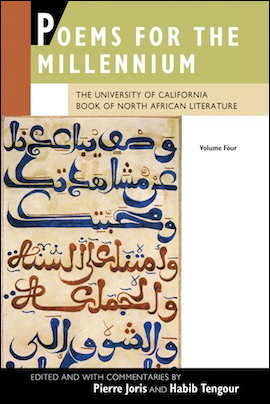Asymptote Review of Millennium Vol IV
Beatriz Leal Riesco reviews Poems for the Millennium, Volume Four: The University of California Book of North African Literature
Edited by Pierre Joris and Habib Tengour (University of California Press, 2013)

For centuries, the achievements of the Arab and Berber Muslim cultures were silenced in the West, and literary traditions and genres greatly in their debt were grafted on to surrogate Greco-Roman or Judeo-Christian genealogies. With the exception of a few novelists and one or two poets, North Africa remains a blind spot for many readers of today, irrespective of its intellectual, cultural, and artistic fecundity. The work of Joris and Tengour serves as redress for the harm this ignorance has done, not only to the authors of the Maghreb, but also to the occidental poetic imagination. The poets here on display, schooled in cultures of chant and verse, skilled employers of dialect and masters in the play of subversion of sonority and rhyme that gives Arabic poetry its specific charm, recover a space that should never have been stripped from them through this lavish paean to their creative vigor.
Rendering homage to the librarians of Alexandria and Al-Andalus, who for centuries safeguarded the wisdom of the Orient and Ancient Greece, Joris and Tengour have worked both as assemblers and interpreters of this mass of texts that took shape organically over the course of more than a quarter-century. Divided into six sections organized chronologically, each with an introduction providing historical background, and interspersed with brief but illuminating commentaries, the text brings together the traditional, the folkloric, and the experimental. The intention in each part is to remain faithful to the spirit of the era, and to dispense with the sort of scholarly hairsplitting that cordons off the creative energies common to the various currents of poetic praxis into academic subspecialties that rob them of their vitality.
As the editors explain in the introduction, for years the book’s working title was Diwan Ifrikiya. In Arabic a diwan is “a gathering, a collection or anthology,” and Ifrikiya is an Arabization of the Latin word Africa, which was itself borrowed from the Egyptians, who used the term Ifri to describe the inhabitants of North Africa. In an opening salvo entitled “A Book of Multiple Beginnings,” the authors recruit such notables as Apuleius, Callimachus, Tertulian, and Saint Augustine, grandees of antiquity whom the occidental tradition divested of their African origins. They are introduced by a creation myth transcribed by the great Africanist Leo Frobenius, symbolically marking the recognition of a literary counter-tradition over which the Western Canon has been overlaid as both obligation and inevitability. […]
continued here

 Poasis II: Selected Poems 2000-2024
Poasis II: Selected Poems 2000-2024 “Todesguge/Deathfugue”
“Todesguge/Deathfugue” “Interglacial Narrows (Poems 1915-2021)”
“Interglacial Narrows (Poems 1915-2021)” “Always the Many, Never the One: Conversations In-between, with Florent Toniello”
“Always the Many, Never the One: Conversations In-between, with Florent Toniello” “Conversations in the Pyrenees”
“Conversations in the Pyrenees” “A Voice Full of Cities: The Collected Essays of Robert Kelly.” Edited by Pierre Joris & Peter Cockelbergh
“A Voice Full of Cities: The Collected Essays of Robert Kelly.” Edited by Pierre Joris & Peter Cockelbergh “An American Suite” (Poems) —Inpatient Press
“An American Suite” (Poems) —Inpatient Press “Arabia (not so) Deserta” : Essays on Maghrebi & Mashreqi Writing & Culture
“Arabia (not so) Deserta” : Essays on Maghrebi & Mashreqi Writing & Culture “Barzakh” (Poems 2000-2012)
“Barzakh” (Poems 2000-2012) “Fox-trails, -tales & -trots”
“Fox-trails, -tales & -trots” “The Agony of I.B.” — A play. Editions PHI & TNL 2016
“The Agony of I.B.” — A play. Editions PHI & TNL 2016 “The Book of U / Le livre des cormorans”
“The Book of U / Le livre des cormorans” “Memory Rose Into Threshold Speech: The Collected Earlier Poetry of Paul Celan”
“Memory Rose Into Threshold Speech: The Collected Earlier Poetry of Paul Celan” “Paul Celan, Microliths They Are, Little Stones”
“Paul Celan, Microliths They Are, Little Stones” “Paul Celan: Breathturn into Timestead-The Collected Later Poetry.” Translated & with commentary by Pierre Joris. Farrar, Straus & Giroux
“Paul Celan: Breathturn into Timestead-The Collected Later Poetry.” Translated & with commentary by Pierre Joris. Farrar, Straus & Giroux
Congrats!!!